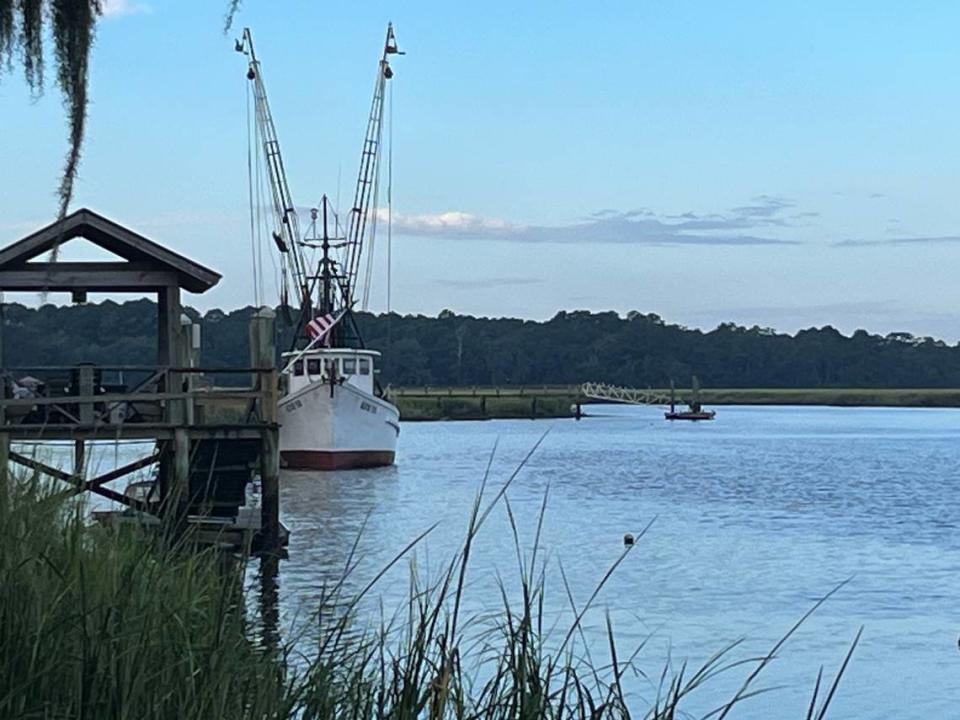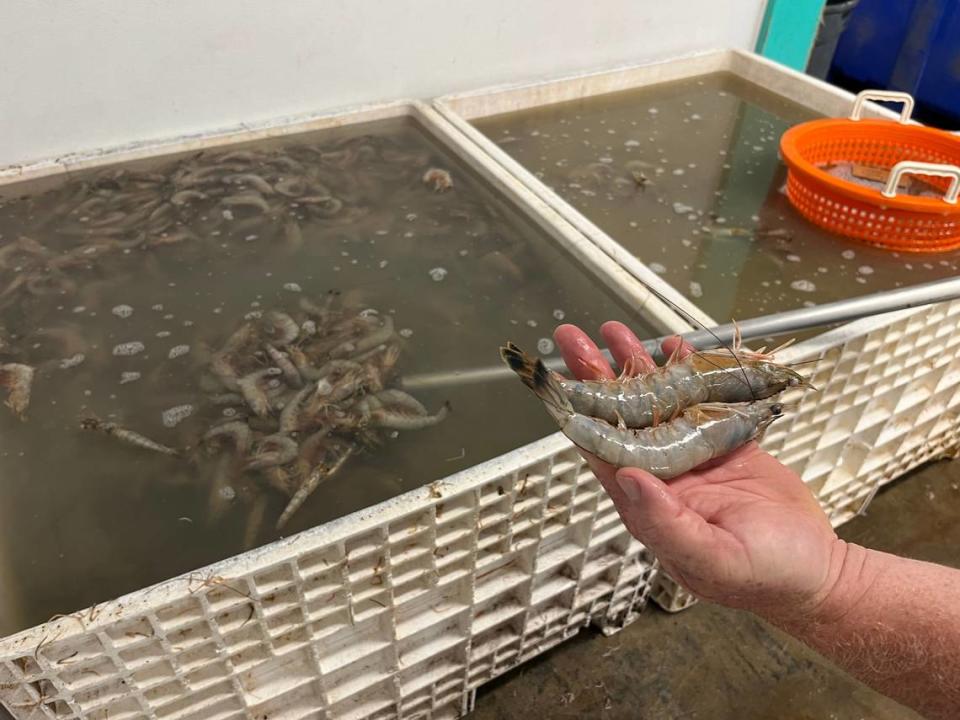Beaufort’s shrimping industry on the brink. Local boats sit while imported catch floods market
Thursday at Village Creek on St. Helena Island was another picture postcard-worthy morning with an American flag lilting in a slight southeast breeze near the shrimper Gracie Bell — idly tied to the dock. At Sea Eagle Market, a catch of shrimp swept up in the nets of trawlers in recent days are being processed by small group of dockside workers. They clean the valuable seafood crop harvested from waters as far away as North Carolina to the northeast coast of Florida before being sold locally and up and down the Palmetto State’s coast.
After this recent harvest was completed, the boats returned, as they always do — to Village Creek, home base for shrimping on Fripp and Hunting Islands in Beaufort County and beyond.
Against this serene backdrop, a storm is brewing that threatens destruction. It is not the threat of foul weather, these shrimpers have seen generations of bad weather days. The storm brewing is economic for the community of shrimpers and related businesses. Just as the profitable autumn white shrimping season approaches, Lowcountry mom and pop shrimp businesses like Sea Eagle Market are feeling the squeeze — tying up more of their boats because of a looming financial crisis that some say could sink the industry.
The problem, says the Southern Shrimp Alliance (SSA), is a glut of farm-raised shrimp is flooding the U.S. market, sending prices plummeting.
“When it’s all said and done, if you didn’t lose money this year, you did good,” says Sea Eagle Market owner Craig Reaves, wearing white rubber boots as he prepares to deliver more than 1,000 pounds of shrimp 175 miles north to Myrtle Beach, where it will end up in restaurants and grocery stores.
Reaves serves on the board of directors of SSA, which is raising alarm bells, trying to get the attention of shrimp state governors and the federal government — even President Joe Biden.
The group, which represents shrimp fishermen and processors in Alabama, Florida, Georgia, Louisiana, Mississippi, North Carolina, South Carolina, and Texas, is pressing governors in those states to seek a region-wide fishery resource disaster declaration from the federal government. The “unprecedented catastrophic crises,” it says, is threatening the very existence of the U.S. shrimp fishing.
“It’s very bad,” Reaves said. “There’s nobody in the shrimping industry right now alive, above ground, that has seen anything close to this.”
Reaves owns Sea Eagle Market in Beaufort and operates shrimp boats from Village Creek docks on St. Helena Island. From this location, shrimp boats connect to the Morgan River, then head east to St. Helena Sound and finally the Atlantic Ocean. But Reaves and SSA say many shrimp boats across the southeast Atlantic and Gulf of Mexico regions have been tied up for a couple of months because of the poor prices.

Usually, disaster declarations for shrimpers are declared because of natural calamities, maybe a freeze or a hurricane, Reaves said.
In this case, SSA is asking taking a different tack, asking for a disaster determination because of what it calls unfair trade practices and farm-raised fish being “dumped” in the U.S. market, overwhelming demand, Reaves says.
“I don’t know how that is all going to play out and nobody does,” Reaves said.
As a result of the poor prices, Reaves said, local boats are limited in what they catch because his market is shrinking. “We’re not going out there and catching everything we could catch,” Reaves said.
Reaves used the analogy of tomatoes grown on St. Helena Island to illustrate the crisis shrimpers are facing. Each summer, truckloads of tomatoes are sent out continually for six weeks. From Beaufort County, they are trucked to consumers across the East Coast.
“If they only produce what could be consumed in Beaufort County, how much would the tomato industry suffer?” Reaves said. “It would be decimated. And that’s what’s happening here. We are only catching what we can sell in our niche market. All the big buyers are shut down. “
The fall shrimp season is right around the corner. Historically, that’s the best time of the year because cooler water temperatures improve the quality of the catch, Reaves said.
Reaves has been reaching out to mayors in Beaufort, Port Royal, Hilton Head and Edisto Beach encouraging them to contact South Carolina Gov. Henry McMaster to urge him to support a federal disaster declaration.
The SSA is pressing governors of Alabama, Florida, Georgia, Louisiana, Mississippi, North Carolina, South Carolina and Texas to support a collective request for a fishery resource disaster determination from the U.S. Secretary of Commerce.
The determination would allow shrimpers to receive financial relief payments. “The U.S. shrimp fishery throughout the Gulf of Mexico and Southeast region is suffering an unprecedented catastrophic crisis that threatens its very existence and the many small family owned businesses that are at the core of the economies of coastal communities throughout the region,” says a SSA letter to the governors.
In 2022, the letter says, federal legislation was passed that revised federal fishery disaster assistance rules giving the Secretary of Commerce the authority to make a “fishery resource disaster” determination if the disaster results in a significant loss of access and revenue due to something beyond the control of fishery mangers. The SSA contends that global supply of predominately farm-raised shrimp overwhelmed U.S. inventories of wild-caught shrimp “driving prices paid to shrimp fisherman to records lows that cannot cover the costs of a shrimp fishing trip.”
“The demand is not there, and the prices paid to fishermen are at historic lows,” SSA Executive Director John Williams said in a statement.
Historically high fuel prices and inflation are exacerbating the problem — and COVID-19.
During the pandemic, overseas markets shrank, and more shrimp were imported, SSA says. U.S. imports of frozen warm-water shrimp nearly doubled from 2013 to 2021 to an unprecedented 1.8 billion pounds.
Reaves laments that large grocery store chains located in the heart of shrimp country don’t even carry wild-caught Lowcountry shrimp although he is able to sell to some independent owners like the Piggly Wiggly at Coligny Plaza on Hilton Head. Most of what is found in the larger chain stores is farm-raised product.

“We appreciate our community support,” Reaves says. “That’s what’s really important is having an educated customer base. “
Shrimpers from Texas to North Carolina are in the same boat, Reaves said. About 12 large trawlers operate out of Beaufort County in addition to 20 or 30 smaller boats. Everybody is hurting, he says.
The majority of shrimp are traditionally sold in restaurants, SSA says. But when restaurants closed during COVID, shrimp buying at retail/grocery stores saw an upswing. Retailers expected demand to carry over or increase in 2022 and foreign shrimp producers increased production. That, in turn, led to an oversupply when consumer demand tapered off due to inflation.
“Boats coming in from shrimping have nowhere to sell because cold storage has been filled,” said Debbie Long, an SSA spokeswoman for the Alliance. “Volumes continue to go up but the value has dropped.”
Landings in South Carolina in 2023 were 88.2% below the historic average as of May, according to the Alliance.

